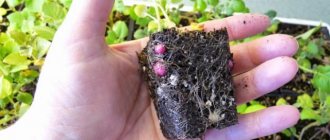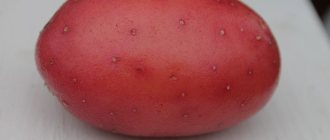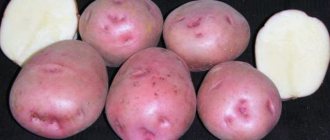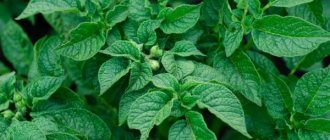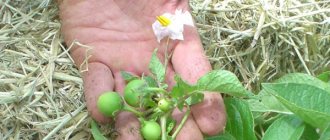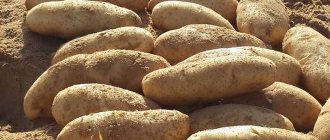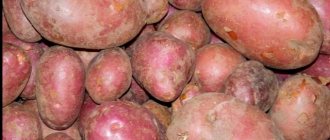Vegetable growing » Potatoes
0
1700
Article rating
Kira Stoletova
These potatoes belong to the early ripening variety and are considered table potatoes. It is often called elite, as its taste and yield are truly impressive. The Barin potato variety is a new development by breeders, but experts are confident that very soon this type of vegetable crop will become very popular among a large number of farmers.
Description of potato variety Barin
Description of the potato variety Barin
The table potato variety was created for cultivation on a production scale for the food industry. High productivity and ease of care for most farmers have become priorities in choosing the Barin variety for cultivation. Potatoes have appeared on the agricultural market relatively recently, but have taken a leading place in household plots and summer cottages.
Based on the ripening time of tubers, the crop can be classified as an early variety; potatoes reach biological ripeness 2.5 months after emergence. The stage of conditional ripeness, when “new” potatoes are suitable for consumption, occurs after 45 days. Unripe tubers differ slightly from ripe ones; they contain an insufficient amount of dry substances, and the pulp is more watery. Due to the low concentration of starch, root vegetables do not crumble when cooked.
According to the characteristics of the Barin potato variety and reviews from vegetable growers, the plant tolerates low temperatures and moisture deficits well. If sprouts are damaged by night frosts, the crop quickly recovers. Lack of moisture does not affect growth; waterlogging of the soil can provoke bacterial and fungal infections; the immunity of the variety is average.
External description:
- The bush is of medium height (within 50 cm), formed by six stems. The shoots are of medium thickness, slightly drooping to the sides, light green, and fragile when exposed to excess moisture.
- The foliage of the plant is intense, the leaves are a shade darker than the stem, round in shape, elongated upward, with uneven wavy edges. The surface of the leaf plate is slightly corrugated, with clearly defined veins.
- Purple flowers with a bright yellow center form panicle inflorescences.
- The root system is compact, does not grow to the sides, and forms up to fourteen root crops.
- The average weight of the tubers is 85–125 g, the shape is oval. The variety does not produce non-marketable (small) potatoes.
- The peel is strong, beige, with pink pigmented eyes at the site of formation.
- The pulp is white, tender, and does not oxidize at the cut site.
Important! Thanks to the aligned tubers, the Barin variety is convenient for mechanized harvesting.
Characteristics of the variety
The description of the Barin variety says that this species first appeared at the A.G. Lorch Research Institute in the Moscow region. Barin’s “parent” was the early potato Baron, originally from the Urals, whose characteristics the breeders really liked, because it is resistant to temperature changes and diseases.
The peculiarity of Barin is that it belongs to the early-ripening varieties, so after 60-70 days the first shoots can be observed. Some farmers dig up the crop ahead of schedule and note that under favorable conditions, Barin is ready for consumption after 50 days.
Description of the plant
Externally, Barin is an upright bush, the branches of which deviate slightly to the side. The leaves are small in size and their color is rich.
Slightly wavy edges of foliage are a characteristic feature of the Barin potato variety. This plant can be called a garden decoration, as it produces amazing pink-purple flowers. From 10 to 12 tubers can ripen on a bush.
Description of the fruit
The emerging potatoes have a creamy-beige skin, pale flesh without wateriness, and pinkish eyes. The potato is oval in shape, smooth, and its weight is from 80 to 120 g.
The resulting harvest can be used for a variety of purposes. Potatoes have 15% starch, have a pleasant taste, do not become overcooked and can be used for frying, boiling and even cooked as French fries.
Taste qualities of potatoes
According to the 5-point tasting scale of the State Varietal Commission, the taste of Barin potatoes was rated 5 points. It is a rare occasion for a culture to receive the highest rating. Due to the high concentration of dry substances, the variety is used for the production of chips of the same name. Tubers contain 15% starch - this is an ideal indicator for culinary processing. The fruits are moderately crumbly, but retain their shape and are not very hard. The variety has proven itself well with any method of heat treatment.
Landing rules
The agricultural technology of the Barin potato variety has a standard procedure. There are no special conditions for planting and growing. Like all types of root crops, this plant requires fertile soil, but it can be successfully cultivated in many soils.
Planting Barin potatoes should begin in early May, when the soil warms up to + 14 0C.
Important! During night frosts, young shoots can completely die, although the plant will sprout new shoots, this will slow down growth, which will lead to later ripening of the crop.
The most common planting method is “on a shovel,” when holes 10 cm deep are dug in a row at a distance of 20-30 cm. The rows are made 50-70 cm apart.
Pros and cons of the Barin potato variety
When grown in the Central region, Barin potatoes fully meet the characteristics declared by the originator. The advantages of the variety include the following qualities:
- adaptability to temperate climate conditions;
- rapid restoration of sprouts after freezing;
- drought resistance;
- unpretentiousness to soil indicators;
- optimal concentration of starch and dry substances;
- highest gastronomic score;
- high productivity;
- stable formation of root crops;
- good transportability;
- long shelf life with minimal losses;
- attractive presentation.
The disadvantages include average immunity to a number of diseases and poor tolerance to waterlogging.
Advantages and disadvantages
Barin potatoes have certain positive qualities that vegetable growers and farmers need to pay attention to. For example, these are qualities such as:
- suitability for cultivation on any soil;
- fairly rapid ripening of tubers;
- uniformity and good shape of potatoes;
- suitability for preparing a wide variety of potato dishes;
- good transportability of tubers and their keeping quality.
The disadvantages of the Barin variety are expressed in the possible susceptibility to late blight and the susceptibility of plants to nematodes. But the possible occurrence of these diseases can be eliminated by proper agricultural technology and by taking preventive measures: treating the soil against nematodes and spraying the bushes with fungicides.
Planting and caring for Barin potatoes
Barin potatoes are planted in the garden in the first half of May. A prerequisite is that the soil must warm up at least +14 0C, and the threat of night frosts must pass. Frozen sprouts die when frozen on the ground, but the plant sprouts new shoots, and the tubers ripen later.
Selection and preparation of a landing site
The location for the garden bed is determined in an open area. In the shade, the growing season slows down, the potatoes ripen later and produce smaller tubers.
Attention! For photosynthesis, the Barin variety requires a sufficient supply of ultraviolet radiation.
The plant does not tolerate waterlogging of the soil; lowlands where rainwater collects and areas with close groundwater are not considered for planting. The crop is unpretentious to the composition of the soil, but on sandy loam, well-drained soil, the yield will be higher.
The plot for potatoes is prepared in the fall. They dig up the soil to the depth of a shovel, and remove the roots of the weeds. If the soil is acidic, neutralize the composition with dolomite flour or lime. Compost is scattered on top. In the spring, the bed is dug up again and saltpeter is added.
Preparation of planting material
According to the description of the variety, Barin seed potatoes are planted on the plot after preliminary germination. Planting material can be prepared independently or purchased at the agricultural market; the tubers should weigh no more than 70 g.
Seed preparation:
- Tubers harvested in the fall are sorted out and damaged ones are removed.
- Spread in a thin layer on a flat surface or place in boxes with 1/3 of the container.
- Place in a lighted room with a temperature of +150 C.
Potatoes germinate in about 30 days; work is approximately carried out in early April. The sprouts should stretch up to 2.5 cm.
Before placing on the garden bed, planting material is treated with an antifungal agent or a solution of manganese with boric acid. According to reviews from vegetable growers, Barin treatment of seed potatoes protects the plant by 90% from fungal infections and nematodes.
Landing rules
There are two methods for planting Barin potatoes: in single holes (under a shovel) or in pre-punched furrows. The depressions are made 20 cm deep. The tubers are laid out (sprouts up) in 2 pieces. at a distance of 8 cm between them. Leave 40 cm between bushes, 45 cm between rows. Cover the top with a layer of peat and ash in equal proportions, then with soil.
Watering and fertilizing
During the dry season, Barin potatoes are watered at the root 3 times: at the time of germination, during flowering, and 21 days after the second watering. If precipitation falls at least once a month, the variety does not require additional moisture. The plant is fed with superphosphate 3 weeks after planting, and 7 days later with potassium-containing agents and urea (urea). At the time of flowering, the variety is fertilized with nitrogen-containing compounds.
Loosening and weeding
When a hard crust appears on the soil surface, loosening is necessary. In this case, the root system does not receive enough oxygen for vegetation. The first loosening is carried out when the potatoes have completely sprouted, subsequent ones - as needed. Weed the potatoes as the weeds grow. After weeding, the weeds along with the roots are removed from the potato bed.
Hilling
When the Barin potato forms tops about 25 cm high, it is hilled. Tubers planted in single holes are covered with soil up to the top leaves; if planted in furrows, they are hilled on both sides with a continuous ridge. After 3 weeks, the hills and ridge are trimmed, the top layer is loosened and the weeds that have grown during this time are removed.
Agricultural technology
Gardeners must understand that even the best elite potato varieties need proper care and proper planting. Barin is an unpretentious variety, but for the sake of an impressive harvest, the farmer will have to work hard.
Selecting a location
Like any potato, Barin loves sunny areas in open areas. If there is not enough sun, the potatoes will develop more slowly than expected, and will begin to hurt and wither. Overmoistening is also dangerous: stagnation of moisture or leakage of groundwater.
Advice! You should not plant potatoes where nightshade crops (tomatoes, peppers, eggplants) grew last season, since the diseases of these plants are the same.
Soil preparation
You need to start preparing for the next season in the fall. During this period, the soil on the site is dug up to the depth of a spade bayonet. After this, you can sprinkle fertilizers: rotted manure, bird droppings, superphosphate, wood ash. With the onset of spring warmth, the fertilized soil is dug up again.
Experienced farmers recommend enriching the soil with green manure (for example, mustard). Such plants are sown a couple of weeks before planting potatoes; immediately before planting the tubers, the soil is dug up along with the sprouts.
Seed selection and preparation
It is better to select seed potatoes of the Baron variety in the fall. Tubers weighing up to 70 grams, the length of which does not exceed 4-5 cm, are optimal for planting. All planting material must be inspected for damage (mechanical, signs of infection or rot).
About a month before the intended planting, it is recommended to treat Baron's tubers with a weak solution of manganese (about ten crystals per liter of water). After this, the potatoes are dried and placed in wooden boxes in one layer for germination.
Important! Baron potatoes need to be sprouted in a warm and bright place with a constant temperature of 10-15 degrees.
By the time of planting, the tubers should have thick and short sprouts, the length of which will not exceed 1-2 cm.
Landing technology
Potatoes of the Barin variety should be planted as follows:
- Dig holes about 18-20 cm deep with an interval of 45-50 cm. You can plant these potatoes in trenches: the depth will be the same, and the potatoes are laid so that there is at least 45 cm between adjacent tubers.
- One potato is placed in each hole so that the large sprouts on the tuber “look” upward.
- Now the potatoes are covered with soil. The soil should only cover the sprouts; do not cover the potatoes with too thick a layer of soil.
- Planting ends with the ground being carefully leveled using a rake.
Attention! It is necessary to level the soil, because this way the tubers will receive more air and moisture circulation will be normalized.
Rules of care
Barin, like any other potato, will have to be looked after in the first half of summer. To achieve a record harvest of this potato variety, you need to put in a lot of effort: watering, hilling, fertilizing and cultivating the bushes.
All care for the Barin variety consists of several stages:
- Some gardeners underestimate the benefits of hilling potato bushes. Sprinkling soil onto the roots of the plant protects the tubers from overheating, minimizes the risk of the bushes becoming infected with various infections, and promotes moisture retention. It is recommended to hill up Barin potatoes at least twice a season. When the sprouts rise to 15 cm, the soil is raked for the first time, the procedure is repeated after about three weeks - at this time the mounds are slightly increased, making them even higher.
- If necessary, potato beds need to be cleared of weeds. This must be done, because the grass impedes air circulation, becomes an environment for the development of pests and infections, and takes away nutrients and moisture from the potatoes.
- The Barin variety tolerates drought well, so you won’t have to water the potatoes often. During the rainy season, you should forget about watering altogether; you just need to regularly loosen the soil, preventing the formation of a thick crust.
- For normal development and growth, the Barin variety requires at least three feedings per season. Before flowering, the bushes can be fertilized with a urea solution (1 spoon per 10 liters of water). During the period of bud formation, a glass of wood ash and a spoonful of superphosphate are diluted in a bucket of water, and the bushes are watered with the resulting solution. At the flowering stage, it is enough to fertilize with a solution of one superphosphate - a spoonful of the substance per 10 liters of water.
- A couple of times per season, it is recommended to carry out preventive treatment of Barin potatoes with scab and nematode agents. Spraying the bushes with fungicides will not hurt, especially if the summer was wet. Don’t forget about the menace of all varieties of root vegetables – the Colorado potato beetle. This pest can be collected by hand or poisoned with insecticides.
Important! In cool climates, the Barin variety is not affected by scab, so the bushes do not need to be treated for this infection. Scab, as a rule, progresses when the temperature rises to 30 degrees or more.
Diseases and pests
Like most representatives of the nightshade crop, Barin potatoes are affected by a fungal infection, and pests parasitize the plant. The main diseases of the variety include late blight, which manifests itself as spots on the leaves. Eliminate fungal infection with Acrobat. Scab affects tops and tubers; for prevention and treatment, planting material and bushes are treated with the following preparations: “Epin”, “Albit”.
Among the pests, the nematode, which parasitizes the root system of the plant, causes great harm. The planting material and plant are treated with the preparation “Gumi”. If the planting area is small, Colorado potato beetles are collected manually, and the contact agent “Corado” is used against the larvae.
The mystery of the teardrop-shaped potato
I’ve been meaning to write for a long time, but I kept putting it off, and now, without waiting for anyone to write about the Gola variety of potatoes, I decided to tell the readers that they are in no way inferior to such celebrities as Sonny and Tuleyevsky.
We bought it by accident: we went to a seed store in May 2013, and they sold different varieties of nodules. We read the characteristics and decided to take three tubers of Lyubava and Gala for testing.
They planted them together with their potatoes, which had already been tested over the years, and grew them without distinguishing them in any way - weeded, hilled, watered if necessary, and in the fall they counted the harvest. Lyubava was rejected: they only dug up half a bucket, and even then it was kind of cracked. Apparently, she didn’t like our sand with humus. But Gola was pleased: they dug up a 10-liter bucket, and the whole thing was a sight to behold - smooth, white, clean, with yellow flesh.
They left it for seeds and the next year they dug up 16 buckets! The variety is mid-season, we remove it after Sonny and Tuleyevsky
. The stems are powerful, and the hilled nests noticeably increase in size over the summer. If there is not enough land, the tubers turn green, so you either have to immediately rake up larger piles, or then rake up the soil with a hoe.
But what puzzled me was the shape of the tubers: more than half are teardrop-shaped. I read somewhere that this is a sign of degeneration of the variety, but what kind of degeneration if the seeds are elite and we have only been growing the variety for three years!
And then I decided to carefully dig out the hole. It turned out that the tubers in it were arranged like chamomile. I took a photograph, although the picture is not entirely clear, the tubers are clearly visible, tightly adjacent to each other not only in the horizontal, but also in the vertical plane. So that's where the teardrop shape comes from!
Harvesting and storage
Barin potatoes ripen by mid-August; the readiness of the root crop for harvesting is determined by the condition of the tops: they wither and begin to dry. The harvest falls on a hot time, so dug up potatoes are not left in the garden. The sun's rays provoke the synthesis of corned beef, and the surface of the tuber turns green. The substance is toxic to humans. The dug-out crop is put into the shade and scattered to dry. Then they sort. Transfer to storage room.
Important! Mandatory requirements for storage space: no light, air temperature not higher than +40C, humidity 80%.
If the conditions are met, Barin potatoes retain their presentation and taste until the end of May. The variety is characterized by high keeping quality (96%).
Features of cultivation
After planting in the first half of summer, Barin potatoes require a lot of care. In order for the harvest to turn out well, watering, loosening and hilling must be carried out.
During the season, the variety requires at least three waterings. The first irrigation is carried out at the time of germination, the second - during the flowering period, and the last three weeks after the second watering.
If possible, you can fertilize the potatoes. As a rule, it is carried out three weeks after planting. Superphosphate is used for this. After another week, potassium-containing complexes and urea should be added. And at the time of flowering, the plant will require nitrogen-containing compounds.
Loosening and hilling potatoes is a very important process, since root crops need sufficient oxygen. And when a hard soil crust appears, soil aeration decreases; it must be periodically destroyed. In addition, at the time of loosening, weeds are removed. Hilling prevents overheating of root crops, which reduces the risk of various diseases and also minimizes moisture loss.
Characteristics and purpose of tubers
Barin's potatoes are oblong, oval, the average weight of each is 90–125 g. The skin is cream-colored, the flesh is white. The keeping quality of the variety is 96%, that is, almost all potatoes are stored until spring.
Barin's tubers are oval, cream-colored
Tasters of the State Sorting Commission rated the taste “excellent.” The advantage of the variety is its increased content of dry substances, which is valued in the production of chips. The less water in the tubers, the greater the yield of the finished product, because crispy potatoes are a dehydrated product. In addition, Barin contains few sugars, which caramelize when fried. The chips are tender and melt in your mouth.
Another plus is that the tubers do not turn black after heat treatment. In home cooking, Barin is suitable for making soups, fried potatoes, and mashed potatoes.
How to care
Like any plant, Barin potatoes require a number of procedures that help achieve a good harvest. It should be:
- hilling;
- weeding;
- watering;
- feeding with fertilizers.
Despite the fact that many farmers do not consider hilling an important procedure, it is still better to carry it out in order to protect the plants from diseases. It is enough to hill up the potatoes only twice, and the first time this is done when the shoots reach 15 cm in height, and the second time - after 21 days, and then the soil is loosened with a hoe.
There are usually no difficulties with weeding, since it is only enough to regularly destroy the weeds so that Barin receives the necessary moisture and air.
Watering is done in such a way that there is no overflow of water. This potato variety tolerates both moisture and drought well, but you shouldn’t overdo it. The formation of a crust on the soil is unacceptable, so in dry and sunny weather it is advisable to water the potatoes twice a day.
Fertilizers for Barin
As for feeding the soil and enriching it with minerals and nutrients, fertilizing should be done at least 3 times. Before the flowers appear, it is necessary to use urea in proportions of 1 tbsp. spoon per 10 liters of water. This helps form healthy stems and bushes.
It is better to fertilize the seedlings the second time during the period when the buds appear. Here ash will come to the rescue, which should be used in a concentration of 1 glass per 10 liters of water. spoon of superphosphate.
Read also: Pepper variety Health: description with photos, characteristics and reviews, cultivation features
The third feeding is carried out during the period of flowering and tuber formation. In this case, 1 tbsp is enough. spoons of superphosphate per 10 liters of water. It is recommended to water with fertilizers in the morning before the sun appears or in the evening after it sets to avoid burns to the leaves.
